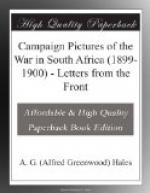The Boers never dreamed that it was possible for our troops to move with such machine-like precision as to hold every nek at our mercy. But whilst Rundle held the ground to the south, and kept the Boers for ever on the move by his restless activity, Clements and Paget moved on Slabbert’s Nek, Hunter swept down on Retief’s Nek, Naauwpoort Nek was invested by Hector Macdonald, Bruce Hamilton closed in upon Golden Gate, and the great net was almost perfect in its meshes. The enemy did not realise their danger until it was too late for the great bulk of their force to escape. Commandant De Wet saw the impending peril at the eleventh hour, and tried hard to get his countrymen to follow him in a dash through Slabbert’s Nek; but very few of the burghers would believe that the sword of fate was hanging by so slim a thread over their heads. In vain this able soldier of the Republic harangued them. Vain all his threats and protestations. They could not and would not believe him. Sullenly they sat in their strongholds and watched Rundle—they could see him, and that danger which was present to their eyes was the only danger they would believe in; and day by day, hour by hour, the cordon of Britain’s might drew closer and closer, until every link in the vast chain was practically flawless. Then Commandant De Wet gathered around him about 1,800 of his most devoted followers, and with Ex-President Steyn in their ranks they passed like ghosts of a fallen people through Slabbert’s Nek on towards the Transvaal. How they managed to elude the incoming khaki wave some other pen must tell. It was a splendid piece of work on the Republican Commandant’s part, and history will not begrudge him the full measure of praise due to him. Had General Prinsloo and his burghers been guided by him, these pages had never been written, for where De Wet took his 1,800 burghers he could as easily have taken 6,000.




